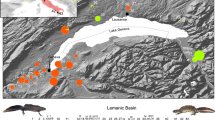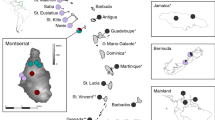Abstract
Anthropogenic introduction of species is a major contributor to loss of biodiversity. Translocations within the range of a species are less frequently recognized, but have the potential for negative effects as well. Genetic mixing may lead to loss of local adaptations or further decline through outbreeding depression. These cryptic invasions may be quite difficult to recognize, but genetic tools can be used to recognize and monitor such intraspecific introductions. Conversely, translocations within species can be an important conservation tool to reduce inbreeding depression and replace lost genetic diversity. Thus, cryptic invasions can be either an aid or a hindrance to conservation efforts. We tested for the presence of non-native genotypes and assessed the extent and nature of introgression in populations of Northern Leopard Frog (Rana pipiens) in the southwestern US, where populations have declined to a few remnant populations. The most abundant and diverse complex of populations in the region contained a mitochondrial haplotype that was not native to the western US, probably resulting from the introduction of released pets, laboratory animals, or release during fish stocking. These non-native haplotypes were well integrated into a large complex of ponds and lakes, contributing to high genetic diversity in this area. Logistically, the geographic extent of non-native genetic influence within this population precludes eliminating or controlling the non-native component of this population. We recommend assessing the progress and fate of the introgression over time—along with population fitness parameters—to determine whether this introduction is beneficial or detrimental to population persistence. Meanwhile, translocations from nearby locations with similar environmental conditions have the best prospects for avoiding problems with outbreeding depression in other declining populations and will also most effectively preserve regional genetic diversity.





Similar content being viewed by others
References
Aitken SN, Whitlock MC (2013) Assisted gene flow to facilitate local adaptation to climate change. Ann Rev Ecol Evol Syst 44:367–388
Allendorf FW, Leary RF, Spruell P, Wenburg JK (2001) The problem with hybrids: setting conservation quidelines. Trends Ecol Evol 16:613–622
Barton NH, Hewitt GM (1989) Adaptation, speciation and hybrid zones. Nature 341:497–503
Basten CJ, Asmussen MA (1997) The exact test for cytonuclear disequilibria. Genetics 146:1165–1171
Blaustein AR, Romansic JM, Scheessele EA, Han BA, Pessier AP, Longcore JE (2005) Interspecific variation in susceptibility of frog tadpoles to the pathogenic fungus Batrachochytrium dendrobatidis. Conserv Biol 19:1460–1468
Bradley GA, Rosen PC, Sredl MJ, Jones TR, Longcore JE (2002) Chytridiomycosis in native Arizona frogs. J Wildlife Dis 38:206–212
Clarkson RW, Rorabaugh JC (1989) Status of leopard frogs (Rana pipiens complex: Ranidae) in Arizona and southeastern California. Southwest Nat 34:531–538
Clement M, Posada D, Crandall KA (2000) TCS: a computer program to estimate gene genealogies. Mol Ecol 9:1657–1659
Corn PS, Fogleman JC (1984) Extinction of montane populations of the Northern Leopard Frog (Rana pipiens) in Colorado. J Herpetol 18:147–152
Cornuet JM, Luikart G (1997) Description and power analysis of two tests for detecting recent population bottlenecks from allele frequency data. Genetics 144:2001–2014
Davies BR, Thoms MC, Walker KF, O’Keeffe JH, Gore JA (1994) Dryland rivers: their ecology, conservation and management. In: Calow P, Petts GE (eds) The rivers handbook: hydrological and ecological principles, vol two. Blackwell Scientific, Hobokenpp, pp 484–511
Di Rienzo A, Peterson AC, Garza JC, Valdes AM, Slatkin M, Freimer NB (1994) Mutational processes of simple-sequence repeat loci in human populations. Proc Natl Acad Sci USA 91:3166–3170
Drost CA, O’Donnell RP, Mock KE, Theimer TC (2011) Population status and population genetics of Northern Leopard Frogs in Arizona: US Geological Survey Open-File Report 2011-1186. http://pubs.usgs.gov/of/2011/1186/
Edmands S (2007) Between a rock and a hard place: evaluating the relative risks of inbreeding and outbreeding for conservation and management. Mol Ecol 16:463–475
Ellison AR, Tunstall T, DiRenzo GV, Hughey MC, Rebollar EA, Belden LK, Harris RN, Ibáñez R, Lips KR, Zamudio KR (2014) More than skin deep: functional genomic basis for resistance to amphibian chytridiomycosis. Genome Biol Evol. doi:10.1093/gbe/evu285
Fields PD, McCauley DE, McAssey EV, Taylor DR (2014) Patterns of cyto-nuclear linkage disequilibrium in Silene latifolia: genomic heterogeneity and temporal stability. Heredity 112:99–104
Fitzpatrick BM (2008) Dobzhansky-Muller model of hybrid dysfunction supported by poor burst-speed performance in hybrid tiger salamanders. J Evol Biol 21:342–351
Frankham R, Ballou JD, Eldridge MDB, Lacy RC, Ralls K, Dudash MR, Fenster CB (2011) Predicting the probability of outbreeding depression. Conserv Biol 25:465–475
Geller JB, Walton ED, Grosholz ED, Ruiz GM (1997) Cryptic invasions of the crab Carcinus detected by molecular phylogeography. Mol Ecol 6:901–906
Gibbs EL, Nace GW, Emmons MB (1971) The live frog is almost dead. Bioscience 21:1027–1034
Goudet J (1995) FSTAT (version 1.2): a computer program to calculate F-statistics. J Hered 86:485–486
Green DE (2001) Toe-clipping of frogs and toads. Standard operating procedure. United States Geological Survey, National Wildlife Health Center. http://www.nwhc.usgs.gov/publications/amphibian_research_procedures/toe_clipping.jsp. Accessed 27 Aug 2016
Gurevitch J, Padilla DK (2004) Are invasive species a major cause of extinctions? Trends Ecol Evol 19:470–474
Hamilton JA, Miller JM (2016) Adaptive introgression as a resource for management and genetic conservation in a changing climate. Conserv Biol 30:33–41
Hecnar SJ, M’Closkey RT (1997) The effects of predatory fish on amphibian species richness and distribution. Biol Conserv 79:123–131
Hillis DM, Wilcox TP (2005) Phylogeny of the New World true frogs (Rana). Mol Phylogenet Evol 34:299–314
Hoffman EA, Blouin MS (2004a) Evolutionary history of the Northern Leopard Frog: reconstruction of phylogeny, phylogeography, and historical changes in population demography from mitochondrial DNA. Evolution 58:145–159
Hoffman EA, Blouin MS (2004b) Historical data refute recent range contraction as a cause of low genetic diversity in isolated frog populations. Mol Ecol 13:271–276
Hoffman EA, Ardren WR, Blouin MS (2003) Nine polymorphic microsatellite loci for the Northern Leopard Frog (Rana pipiens). Mol Ecol Notes 3:115–116
Holsbeek G, Mergeay J, Hotz H, Plötner J, Volckaert FAM, De Meester L (2008) A cryptic invasion within an invasion and widespread introgression in the European water frog complex: consequences of uncontrolled commercial trade and weak international legislation. Mol Ecol 17:5023–5035
Holsbeek G, Mergeay J, Volckaert FAM, De Meester L (2010) Genetic detection of multiple exotic water frog species in Belgium illustrates the need for monitoring and immediate action. Biol Invasions 12:1459–1463
Keller LF, Waller DM (2002) Inbreeding effects in wild populations. Trends Ecol Evol 17:230–241
Kettenring KM, Mock KE (2012) Genetic diversity, reproductive mode, and dispersal differ between the cryptic invader, Phragmites australis, and its native conspecific. Biol Invasions 14:2489–2504
Kimberling DN, Ferreira AR, Shuster SM, Keim P (1996) RAPD marker estimation of genetic structure among isolated Northern Leopard Frog populations in the south-western USA. Mol Ecol 5:521–529
Latta RG, Linhart YB, Mitton JB (2001) Cytonuclear disequilibrium and genetic drift in a natural population of Ponderosa Pine. Genetics 158:843–850
Longcore JR, Longcore JE, Pessier AP, Halteman WA (2007) Chytridiomycosis widespread in anurans of northeastern United States. J Wildlife Manag 71:435–444
Luikart G, Allendorf FW, Cornuet J-M, Sherwin WB (1998) Distortion of allele frequency distributions provides a test for recent population bottlenecks. J Hered 89:238–247
Mergeay J, Verschuren D, De Meester L (2005) Cryptic invasion and dispersal of an American Daphnia in East Africa. Limnol Oceanogr 50:1278–1283
Metcalf JL, Pritchard VL, Silvestri SM, Jenkins JB, Wood JS, Cowley DE, Evans RP, Shiozawa DK, Martin AP (2007) Across the great divide: genetic forensics reveals misidentification of endangered cutthroat trout populations. Mol Ecol 16:4445–4454
Moriarty ME (2009) Endangered and threatened wildlife and plants; 90-day finding on a petition to list the Northern Leopard Frog (Lithobates [=Rana] pipiens) in the western United States as threatened. Fed Regist 74:31389–31401
Müllenbach R, Lagoda PJL, Welter C (1989) An efficient salt-chloroform extraction of DNA from blood and tissues. Trends Genet 5:391
Nei M (1972) Genetic distance between populations. Am Nat 106:283–292
O’Donnell RP, Mock KE (2012) Two frog species or one? A multi-marker approach to assessing the distinctiveness of genetic lineages in the Northern Leopard Frog, Rana pipiens. Conserv Genet 13:1167–1182
Parris MJ (2001) Hybridization in leopard frogs (Rana pipiens complex): variation in interspecific hybrid larval fitness components along a natural contact zone. Evol Ecol Res 3:91–105
Pask JD, Cary TL, Rollins-Smith LA (2013) Skin peptides protect juvenile leopard frogs (Rana pipiens) against chytridiomycosis. J Exp Biol 216:2908–2916
Pimm SL, Dollar L, Bass OL Jr (2006) The genetic rescue of the Florida panther. Anim Conserv 9:115–122
Pritchard JK, Stephens M, Donnelly P (2000) Inference of population structure using multilocus genotype data. Genetics 155:945–959
Raymond M, Rousset F (1995) GENEPOP (version 1.2): population genetics software for exact tests and ecumenicism. J Hered 86:248–249
Relyea RA (2001) Morphological and behavioral plasticity of larval anurans in response to different predators. Ecology 82:523–540
Rhymer JM, Simberloff D (1996) Extinction by hybridization and introgression. Ann Rev Ecol Syst 27:83–109
Rogers SD, Peacock MM (2012) The disappearing Northern Leopard Frog (Lithobates pipiens): conservation genetics and implications for remnant populations in western Nevada. Ecol Evol 2:2040–2056
Sala OE, Chapin FS III, Armesto JJ et al (2000) Global biodiversity scenarios for the year 2100. Science 287:1770–1774
Saltonstall K (2002) Cryptic invasion by a non-native genotype of the common reed, Phragmites australis, into North America. Proc Natl Acad Sci USA 99:2445–2449
Sasa MM, Chippindale PT, Johnson NA (1998) Patterns of postzygotic isolation in frogs. Evolution 52:1811–1820
Sredl MJ (1998) Arizona leopard frogs: balanced on the brink? In: Mac MJ, Opler PA, Puckett Hacker CE, Doran PD (eds) Status and trends of the nation’s biological resources. US Department of the Interior, US Geological Survey, Biological Resources Division, Washington, pp 573–574
Tennessen JA, Woodhams DC, Chaurand P, Reinert LK, Billheimer D, Shyr Y, Caprioli RM, Blouin MS, Rollins-Smith LA (2009) Variations in the expressed antimicrobial peptide repertoire of Northern Leopard Frog (Rana pipiens) populations suggest intraspecies differences in resistance to pathogens. Dev Comp Immunol 33:1247–1257
Voordouw MJ, Adama D, Houston B, Govindarajulu P, Robinson J (2010) Prevalence of the pathogenic chytrid fungus, Batrachochytrium dendrobatidis, in an endangered population of Northern Leopard Frogs, Rana pipiens. BMC Ecol 10:6. doi:10.1186/1472-6785-10-6
Wier BS (1996) Genetic data analysis II: methods for discrete population genetic data. Sinauer Associates Inc, Sunderland
Wier BS, Cockerham CC (1984) Estimating F-statistics for the analysis of population structure. Evolution 38:1358–1370
Wilcove DS, Rothstein D, Dubow J, Phillips A, Losos E (1998) Quantifying threats to imperiled species in the United States. Bioscience 48:607–615
Wilson GA, Fulton TL, Kendell K, Scrimgeour G, Paszkowski CA, Coltman DW (2008) Genetic diversity and structure in Canadian Northern Leopard Frog (Rana pipiens) populations: implications for reintroduction programs. Can J Zool 86:863–874
Woodhams DC, Ardipradja K, Alford RA, Marantelli G, Reinert LK, Rollins-Smith LA (2007) Resistance to chytridiomycosis varies among amphibian species and is correlated with skin peptide defenses. Anim Conserv 10:409–417
Woodward BD (1983) Predator–prey interactions and breeding pond use of temporary pond species in a desert anuran community. Ecology 64:1549–1555
Acknowledgements
Funding for this work was provided by the Heritage Fund Program of the Arizona Game and Fish Department. A Willard L. Eccles Graduate Fellowship from the Utah State University College of Science provided partial support for Ryan O’Donnell. Lisa Gelczis, Caleb Loughran, A. J. Monatesti, Dan Groebner, Diana Kimberling, Susan MacVean, and Oliver Hyman collected genetic samples. Susan MacVean of the Arizona Game and Fish Department provided assistance, advice, and insights. Jer Pin Chong, Catherine M. Culumber, and Jay Baker contributed to laboratory work. Tara Fulton and Greg Wilson of the University of Alberta provided access to primers and unpublished data. Preliminary portions of this manuscript were published as part of a peer-reviewed US Geological Survey Open-File Report, number 2011-1186.
Author information
Authors and Affiliations
Corresponding author
Rights and permissions
About this article
Cite this article
O’Donnell, R.P., Drost, C.A. & Mock, K.E. Cryptic invasion of Northern Leopard Frogs (Rana pipiens) across phylogeographic boundaries and a dilemma for conservation of a declining amphibian. Biol Invasions 19, 1039–1052 (2017). https://doi.org/10.1007/s10530-016-1320-1
Received:
Accepted:
Published:
Issue Date:
DOI: https://doi.org/10.1007/s10530-016-1320-1




